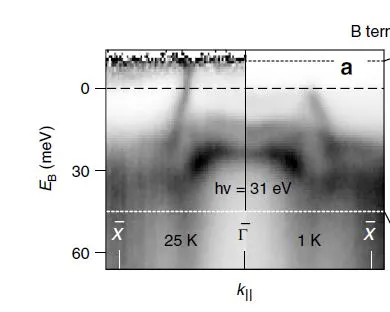40-year controversy in solid-state physics resolved
Samarium hexaboride is a trivial surface conductor
An international team at BESSY II headed by Prof. Oliver Rader has shown that the puzzling properties of samarium hexaboride do not stem from the material being a topological insulator, as it had been proposed to be. Theoretical and initial experimental work had previously indicated that this material, which becomes a Kondo insulator at very low temperatures, also possessed the properties of a topological insulator. The team has now published a compelling alternative explanation in Nature Communications, however.
Samarium hexaboride is a dark solid with metallic properties at room temperature. It hosts Samarium, an element having several electrons confined to localized f orbitals in which they interact strongly with one another. The lower the temperature, the more apparent these interactions become. SmB6 becomes what is known as a Kondo insulator, named after Jun Kondo who was first able to explain this quantum effect.
In spite of Kondo-Effect: some conductivity remains
About forty years ago, physicists observed that SmB6 still retained remnant conductivity at temperatures below 4 kelvin, the cause of which had remained unclear until today. After the discovery of the topological-insulator class of materials around 12 years ago, hypotheses grew insistent that SmB6 could be a topological insulator as well as being Kondo insulator, which might explain the conductivity anomaly at a very fundamental level, since this causes particular conductive states at the surface. Initial experiments actually pointed toward this.
BESSY II: precise measurements of energy levels
Now an international team headed by Prof. Oliver Rader has been able to thoroughly investigate especially good samples of SmB6 at BESSY II. The samples, grown by collaborating partners in Ukraine, were cleaved along specific crystal planes and studied with the help of ARPES 13, the unique high-resolution apparatus for angular-resolved photoemission spectroscopy at BESSY II. The physicists were able to achieve the necessary cryotemperatures down below 1 kelvin and quite precisely measure the energy levels of the various electron bands with respect to the geometry of the crystal.
First analysis: no topological insulator
Their measurements indeed confirmed the result that electrons on the surface are mobile, but simultaneously furnished evidence that the even number of band transitions observed is irreconcilable with the electrons occupying topological surface states.
Shifting of band gaps explains conductivity
In the follow-on experiments, the researchers looked intensively for an alternative explanation of the conductivity that had meanwhile actually been demonstrated at the surface. “We were able to show that the gaps between the permitted energy levels of the electrons which opened up due to the Kondo effect were shifted a bit at the surface. As a result, the sample remains conductive only there. This clearly means, however, that the remarkable surface conductivity is not related to the topology of the system”, explains Dr. Emile Rienks who carried out the experiments with doctoral student Peter Hlawenka (HZB and University Potsdam).
Outlook: spintronics and green IT
The research on topological insulators and other materials that exhibit pronounced quantum effects could lead to new electronic components for energy-efficient information technology. Information might be processed and stored with minimal energy input if we can better understand these materials and thereby control them.
The study is published in Nature Communication (2018):Samarium hexaboride is a trivial surface conductor, P. Hlawenka, K. Siemensmeyer, E. Weschke, A. Varykhalov, J. Sánchez-Barriga, N.Y. Shitsevalova, A.V. Dukhnenko, V.B. Filipov, S. Gabáni, K. Flachbart, O. Rader & E.D.L. Rienks
DOI: 10.1038/s41467-018-02908-7
Contact:
Helmholtz-Zentrum Berlin für Materialien und Energie
Dr. Emile Rienks
ARPES One-Cube
Tel.: (030) 8062-14913
Email: emile.rienks(at)helmholtz-berlin.de
apl. Prof. Dr. Oliver Rader
Department Materials for green spintronics
Tel.: (030) 8062-12950
Email: rader@helmholtz-berlin.de
